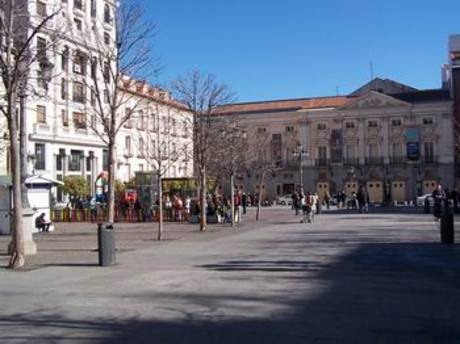Plaza de Santa Ana
The Plaza de Santa Ana, together with the nearby small streets which make up the Huertas district, is one of Madrid's most lively and vibrant areas, with hundreds of tapas bars, terrace cafes, pubs, restaurants and Irish bars all within a relatively small area. The square itself is located just a short walk from both the Plaza Mayor and the Puerta del Sol. It is also possible to walk to Madrid's main museums from here, making this area an ideal location to stay in the city.
Plaza de Santa Ana is a plaza located in central Madrid, Spain, nearby Puerta del Sol and Calle de Huertas, in the Barrio de las Letras. It features numerous restaurants, cafes and tapas bars, with its terraces covering most of the sides surfaces. Two monuments honor some of Spain's most famous writers. At the west side of the square, in front of the cream-colored hotel building stands a marble statue dedicated to Pedro Calderón de la Barca, a 17th century poet and playwright. The monument, created in 1878 by Joan Figueras Vila is decorated with four reliefs that depict scenes from four of Calderón's plays.
A more recent literary monument can be found at the other end of the square, near the Teatro Español. It honors another famous poet and playwright, Federico García Lorca. The statue was erected in 1998, at the centennial birthday of García Lorca.
Pedro Calderón de la Barca y Barreda González de Henao Ruiz de Blasco y Riaño usually referred as Pedro Calderón de la Barca (17 January 1600 – 25 May 1681), was a dramatist, poet and writer of the Spanish Golden Age. During certain periods of his life he was also a soldier and a Roman Catholic priest. Born when the Spanish Golden Age theater was being defined by Lope de Vega, he developed it further, his work being regarded as the culmination of the Spanish Baroque theater. As such, he is regarded as one of Spain's foremost dramatists and one of the finest playwrights of world literature.
Federico del Sagrado Corazón de Jesús García Lorca (5 June 1898 – 19 August 1936) was a Spanish poet, dramatist and theater director. García Lorca achieved international recognition as an emblematic member of the Generation of '27. He is believed to be one of thousands who were summarily shot by anti-communist death squads during the Spanish Civil War.
Teatro Español, the oldest theater in Madrid, is located on the plaza's east side. It was built in seventeenth century and then had the name Corral del Príncipe. On the west side of the plaza, a luxury hotel (now ME Madrid Reina Victoria) was built in the early nineteenth century. The hotel earned fame for being the favorite among the most popular bullfighters. For example, the regular guest Manolete always reserved room number 220 in superstition. The plaza is a popular meeting point in Madrid.
The name derives from a monastery with the name Santa Ana that occupied the current location in the seventeenth century. The origins of the modern plaza go back to Joseph I, who in 1810, with urban sanitation of Madrid in mind, demolished the old Carmelite monastery and the adjoining houses. The plaza began to take its current appearance, which was almost completed in 1880 when buildings that obstructed the view of the Teatro Español was demolished.
Some of Madrid's most popular cafés, restaurants and tapas bars can be found along the Plaza de Santa Ana. The most famous is probably the Cervecería Alemana, frequented by artists and writers since it opened in 1904. Ernest Hemingway was one of the regulars here. Other popular establishments include the Viva Madrid and Los Gabrieles; both are decorated with beautiful azulejos, colorful tiles. You can get there via flight to Madrid.




